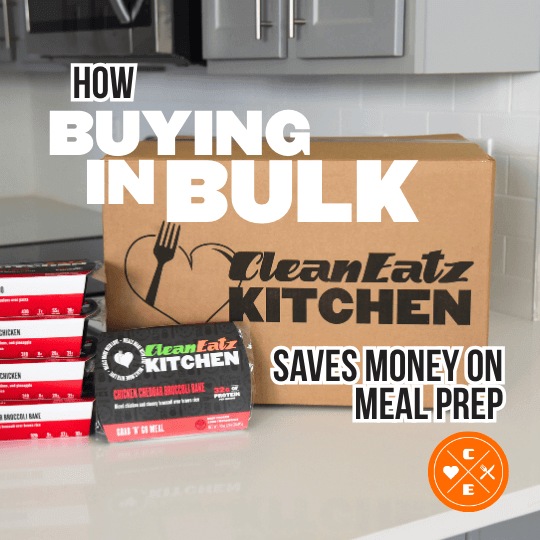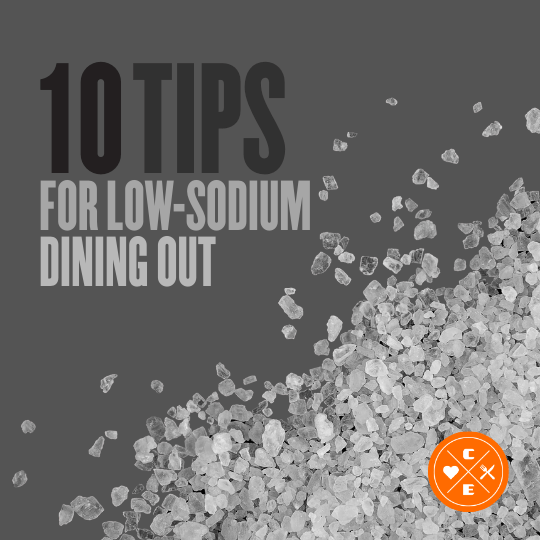How Buying in Bulk Saves Money on Meal Prep

Jason Nista
Healthy Lifestyle
05/06/2025 7:57am
10 minute read
Table of Contents
Want to save money and time on meals? Start buying in bulk.
Here’s why it works:
- Lower Costs: Bulk items cost less per unit. Example? Rice drops from $2.49/lb (small bag) to $1.15/lb (bulk bag).
- Fewer Trips: Shop less often, saving on gas and impulse buys.
- Less Waste: Bulk buying reduces packaging and food waste.
- Easier Meal Prep: Prep large batches using bulk ingredients for quick, budget-friendly meals.
Quick Tip: Store bulk items properly - freeze meats, use airtight containers for grains, and label everything.
Want convenience? Pair bulk buying with pre-portioned meal services like Clean Eatz Kitchen for extra flexibility.
Meal Prep Hacks for Efficiency | Time & Sanity Saving Tips, Recipes
Cost Benefits of Bulk Purchases
Lower Cost Per Unit
Buying in bulk reduces the cost per unit, providing immediate savings.
Price Per Unit Breakdown
To find the cost per unit, divide the total price by the number of units. This method highlights the actual cost of ingredients.
| Item | Regular Size | Bulk Size | Regular Price/lb | Bulk Price/lb | Savings/lb |
|---|---|---|---|---|---|
| Rice | 2 lbs | 20 lbs | $2.49 | $1.15 | $1.34 |
| Oats | 1 lb | 10 lbs | $3.99 | $1.89 | $2.10 |
| Chicken | 1 lb | 10 lbs | $4.99 | $2.99 | $2.00 |
Additional Savings
Buying in bulk doesn’t just save on the price tag - it also reduces hidden expenses.
Fewer Trips to the Store
You’ll save on gas and reduce wear and tear on your vehicle by shopping less often.
Less Packaging Waste
Bulk purchases use less packaging per unit. This not only saves money but also helps reduce food waste. Grocery stores contribute about 16 billion pounds of food waste annually [1].
Fewer Impulse Buys
Shopping less frequently means fewer opportunities to buy unnecessary items, keeping your budget on track.
Monthly Savings Breakdown
Here’s how bulk buying can save you money on meal prep staples:
| Ingredient | Small Package | Bulk Package | Monthly Usage | Monthly Savings |
|---|---|---|---|---|
| Brown Rice | $2.49/2 lbs | $22.99/20 lbs | 8 lbs | $4.97 |
| Quinoa | $4.99/1 lb | $35.99/10 lbs | 4 lbs | $13.97 |
| Chicken Breast | $4.99/lb | $29.90/10 lbs | 10 lbs | $20.00 |
| Mixed Nuts | $8.99/1 lb | $59.99/10 lbs | 3 lbs | $16.98 |
To make the most of these savings, proper storage is essential. Divide bulk items into smaller portions to keep them fresh and ready to use. This simple step ensures your savings go further and helps streamline meal prep.
Budget and Planning Steps
Building on the cost-saving benefits of buying in bulk, start by establishing a clear budget to guide your purchases.
Creating Your Bulk Budget
Take a close look at your grocery spending and set aside a portion specifically for bulk items. While the upfront cost might be higher, the long-term savings are worth it. Keep track of bulk prices and per-unit costs using a spreadsheet - this helps you identify the best times to buy. Use this data to create a practical weekly menu that maximizes your bulk purchases.
Weekly Menu Design
Once your budget is set, focus on designing recipes that make the most of your bulk ingredients.
Meal Planning Strategy:
- Choose 2–3 proteins you can buy in bulk
- Pick grains or starches that work across multiple meals
- Incorporate fresh ingredients for variety
- Set aside time for meal prep
Here’s an example of how to use one protein throughout the week:
- Monday: Grilled chicken with quinoa
- Wednesday: Chicken stir-fry with brown rice
- Friday: Chicken and vegetable soup
Storage Methods and Tips
Storing bulk items properly is key to maintaining their quality and preventing waste.
"Our meals last 12 months in the freezer. We produce, seal, and deep freeze the meals at our kitchens. They are then delivered to you on dry ice. Kept frozen, they last up to 12 months. Kept fresh, they will last a few days."
– Clean Eatz Kitchen [1]
Storage Guidelines:
- Use airtight containers for dry goods and vacuum-seal meats
- Label everything with purchase and expiration dates
- Follow a first-in, first-out system to use older items first
- Keep storage areas at the right temperature:
- Freezer: 0°F (-18°C)
- Refrigerator: 40°F (4°C)
- Pantry: 50–70°F (10–21°C)
Divide bulk items into portion-sized servings as soon as you get them. Clean Eatz Kitchen reported in 2023 that their food waste was less than 1%, thanks to efficient storage and recycling practices [1].
sbb-itb-1989a25
Preventing Bulk Food Waste
Managing bulk purchases effectively helps save money and reduces waste. Once you've set up your bulk budget and storage strategies, the next step is preventing waste. Did you know grocery stores discard about 30% of their food every year? That adds up to 16 billion pounds of waste [1].
Choosing the Right Quantities
To avoid overbuying, track how much you use each month. For instance, if your household goes through 2 pounds of rice weekly, a 25-pound bag might be ideal. Buying a 50-pound bag, however, could lead to spoilage.
Here are some key factors to consider:
| Factor | What to Consider | Example |
|---|---|---|
| Storage Space | How much room you have in your freezer, fridge, or pantry | A 20-cubic-foot freezer holds 100 lbs of meat |
| Usage Rate | How much you consume monthly | 8 lbs of chicken per month |
| Shelf Life | How long the item stays fresh | Dried beans last about 1 year |
| Family Size | Number of people in your household | 4 people = 16 servings per meal |
Once you figure out the right amounts, you can decide whether to freeze portions or organize your pantry to minimize waste.
Freezing and Portioning
After purchasing bulk items, freeze portions immediately to keep them fresh. Dividing food into meal-sized portions prevents repeated thawing, which can reduce quality. Freezing is a great way to extend shelf life.
Here are some freezing tips:
- Use heavy-duty freezer bags or vacuum-sealed containers, and remove as much air as possible.
- Label each package with its contents and the date.
- Keep your freezer at 0°F (-18°C) to ensure proper storage.
Organizing Your Pantry
A well-organized pantry also plays a big role in reducing waste. Use a "first in, first out" (FIFO) system - place newer items behind older ones so you use up older stock first.
Practical pantry tips:
- Store food in clear containers for better visibility.
- Check expiration dates monthly to stay on top of what needs to be used.
- Keep your pantry temperature between 50–70°F (10–21°C).
- Add moisture-absorbing packets to protect sensitive items.
Bulk Ingredients in Daily Meals
Once you've set your budget and planned your storage, these cooking strategies will help you make the most of bulk ingredients.
Tips for Cooking in Bulk
Cooking in large batches saves time and effort. For example, prepare a big pot of rice and divide it into portions for several meals.
| Cooking Method | Efficiency Tip | Shelf Life |
|---|---|---|
| Batch Roasting | Roast 5–6 lbs of vegetables at 400°F | 4–5 days in the fridge |
| One-Pot Meals | Cook 8–10 servings in a large stockpot | 3–4 days in the fridge |
| Sheet Pan Cooking | Bake 3–4 lbs of protein across multiple trays | Up to 4 days in the fridge |
Portioning for Consistency
Using tools like measuring cups and a food scale ensures consistent portions, helping you stretch bulk ingredients while maintaining balanced nutrition.
| Ingredient Type | Single Serving | Weekly Total for a Family of 4 |
|---|---|---|
| Lean Protein | 4–6 oz | Around 7–8 lbs |
| Cooked Grains | ½ cup | 8–10 cups |
| Vegetables | 1 cup | 28–32 cups |
For easier portion control and meal prep, consider bulk meal options from Clean Eatz Kitchen.
Clean Eatz Kitchen Bulk Options
![]()
Clean Eatz Kitchen offers Bulk Boxes with 30 pre-portioned meals, making it simple to stick to your dietary goals.
Their meal plans cater to various needs:
| Meal Plan Type | Features | Benefits |
|---|---|---|
| Weight Loss | Under 600 calories per meal | Helps manage calorie intake effectively |
| High Protein | Balanced macronutrients | Supports muscle growth and maintenance |
| Custom Plans | Tailored to your needs | Fits specific dietary preferences |
Conclusion: Making Bulk Buying Work for You
A well-thought-out bulk buying strategy can help you save money while maintaining the quality and nutrition of your meals. By focusing on frequently used ingredients and comparing unit prices, you can make the most of your budget.
To get the best results, combine bulk purchases with effective meal planning and proper storage. Here are a few strategies to consider:
| Strategy | How to Do It | Why It Helps |
|---|---|---|
| Smart Storage | Use airtight containers and freeze properly | Keeps food fresh longer |
| Portion Control | Divide and measure items right away | Reduces waste |
| Meal Planning | Plan weekly menus around bulk items | Cuts unnecessary costs |
If storage becomes tricky or you’re short on time, Clean Eatz Kitchen's Bulk Boxes can be a convenient solution. These pre-portioned meals are freezer-friendly for up to 12 months, making them a hassle-free way to stay on budget and keep your meal prep stress-free.
FAQs
What are the best ways to store bulk ingredients to keep them fresh and reduce waste?
To keep bulk ingredients fresh and minimize waste, proper storage is key. Dry goods like rice, pasta, and flour should be stored in airtight containers to prevent moisture and pests. For perishables, freeze items like meats, vegetables, or bread in portioned sizes to make them easy to use later. Label everything with the date to track freshness.
Keep your pantry and freezer organized so you can quickly see what you have on hand and avoid buying duplicates. For produce, store items like onions and potatoes in a cool, dark place, while leafy greens stay fresh longer in the fridge when wrapped in a damp paper towel inside a plastic bag.
By planning ahead and storing bulk items correctly, you can stretch your dollar further while reducing food waste.
How can I create a weekly meal plan that makes the most of bulk ingredients?
Creating a weekly meal plan with bulk ingredients is an excellent way to save money and reduce waste. Start by planning meals around versatile staples like rice, pasta, beans, or frozen vegetables, which can be used in multiple recipes throughout the week. Batch cooking is another great strategy - prepare large portions of meals like soups, casseroles, or stir-fries that can be portioned and stored for later.
To avoid waste, make a detailed shopping list and stick to it. Store bulk items properly in airtight containers to maintain freshness. If cooking from scratch feels overwhelming, consider options like chef-prepared meals from Clean Eatz Kitchen, which are portion-controlled, healthy, and delivered frozen for convenience - perfect for supplementing your meal prep routine.
How can I buy in bulk without overbuying or wasting food?
Buying in bulk can save money, but it's important to plan carefully to avoid overbuying and food waste. Start by assessing your meal prep needs for the week or month and creating a detailed shopping list. Focus on versatile ingredients you can use across multiple meals, like rice, beans, or frozen vegetables.
Store bulk items properly to extend their shelf life - use airtight containers for dry goods and freeze perishable items when possible. If you're worried about using everything before it spoils, consider splitting bulk purchases with a friend or family member to share the savings and reduce waste. Thoughtful planning ensures you get the most value out of buying in bulk while keeping your meals fresh and delicious.
Related Articles
How to Take Accurate Body Measurements
9 minute read
Top 7 Apps for Nutrition & Fitness Tracking (2025)
4 minute read
10 Tips for Low-Sodium Dining Out
12 minute read


